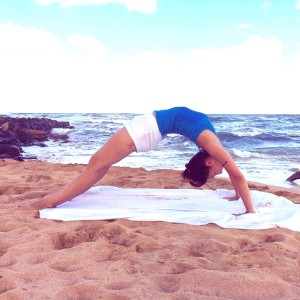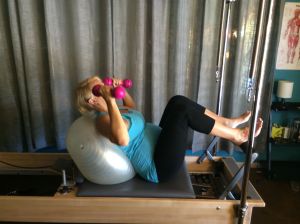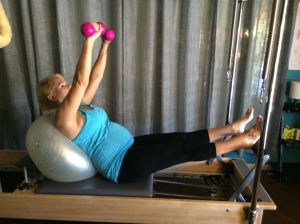The Beauty of Weight-Gain During Pregnancy - Part 1 of 2
body image for moms for teachers May 16, 2019
Hello Beautiful Pilates Teacher!
This is part 1 of 2 of The Beauty of Weight-Gain - a post I wrote in 2015 during my pregnancy, on how we can help our clients better embrace the fact that their bodies WILL change during and after pregnancy.
You'll read, from my perspective as a skinny girl, that I always had the opposite insecurity than most women in that I always WANTED to have more weight on me.
My hope is that it helps you to better understand the pregnant body from the perspective of someone who is active and healthy, and to empathize with women who may not be as active, and the toll it takes on the body, in general.
And in part 2, I will talk about the psychological perspective on weight-gain.
What you'll find in this post:
- Pregnancy Experience (1st Reflection)
- Weight Gain Breakdown (2nd Reflection)
- Adjusting to the Changes (3rd Reflection)
- Joints and Ligaments
- Common Complaints During Pregnancy
- How Pilates Can Help
- Exercise Preparation on the Reformer
- Exercise for upper and lower body
- Resources
Here we go!

(Me 1 week before giving birth in the Summer of 2015)
Skinny Minnie Before Pregnancy
(Originally written in 2015)
I have always been a skinny girl.
The kind of skinny girl who people walk up to and say "you are sooooo skinny!"
And then look me straight in the face and say "I hate you,"
most likely implying they hate that I don't gain weight and that they do.
I've also heard more than once, "You need to eat a sandwich."
Me (Alison Marsh) Kauai, Hawaii September 2014, 2 months before I got pregnant.
I was always insecure about being thin; having very little womanly flesh on me.
So I am gladly embracing this hip and rib-cage widening that is going on, and my flat, muscley stomach that is now protruding from my belly (please don't hate me).
I feel like a woman! I am blessed to have the opportunity to grow a human inside my body!
With the body expanding in all directions, naturally comes discomfort and major adjustments.
I didn't expect how my body would gain weight and expand so quickly, and how I would have to adjust.
Pregnancy Weight Gain Breakdown
Late in my first trimester, within a few weeks, I gained 10 pounds, bringing me to 135lbs. (For perspective, a jug of milk weighs 8-10 lbs., depending on if it is skim or whole.)
I remember having to work harder to move.
- Going up the stairs to the second floor in our house was much more challenging on my legs, and I would lose my breath easily.
- Because of the laxity in my joints and ligaments, particularly in the pelvis, I had to work harder at keeping my pelvic floor and protruding abdominals engaged and lifted.
- Also, fatigue is common in the first trimester, due to the immense changes happening in the body in preparation to house a fetus for 9 months.
All of these major changes are preparing the pregnant body for the marathon of labor and child-birth, also termed "D-Day" for delivery day.
Adjusting to the Changes
Muscles
I am beginning my 7th month now and weigh about 145lb., having gained 20lbs total since becoming pregnant.
Every time I gain, my body feels it, and I have to readjust - working harder than before, yet, becoming stronger than ever!
Dr. Clapp, the writer of Exercising Through Your Pregnancy, shares this about strength:
No one has looked at whether muscle mass or muscle function (the force and velocity of contraction) changes during pregnancy. However, several observations suggest that both muscle mass and strength increase.
First, in the only study which it has been measure, lean body mass after pregnancy was about five percent greater than before pregnancy (Little, Clapp, and Ridzon 1995). As bone mineral is unchanged, the difference is probably due to an increase in muscle mass.
Second, the fact that a woman carries around an additional 20 or more pounds during late pregnancy should increase muscle size and strength in the lower extremities.
Weight gain in pregnancy = stronger muscles!
Joints and Ligaments
Quick Anatomy Review:
Joints
Joints connect bone to bone with the support of ligaments.
- Most joints allow our bodies to move freely: knee joints, hip joints, shoulder joints.
- But some joints provide limited movement such as the SI Joint and the Pubic Symphysis Joint, which are further supported by ligaments.
Ligaments
Ligaments connect from bone to bone in order to form and support a joint, often deriving from the outer layer of the joint capsule.
- Ligaments provide strength and stability to inhibit hyper-mobility of the joint. The pelvic area is covered in ligamentous tissue.
- Ligaments have an abundance of sensory nerve cells, making them capable of responding to movement and speed.
This also makes them capable of sending pain signals to the brain.
- Yet, ligaments have very little blood supply, making them difficult to heal.
- Once a ligament is overstretched, it most likely will not return to its original supportive state - why it is important not to overstretch a pregnant woman.

The joints and ligaments of a woman's hips and pelvis are designed to move and adjust as the pregnancy progresses, in preparation for delivery- "D-day!"
- This is due to the rise in hormone levels, particularly progesterone and relaxin.
- Add weight to hyper-flexible joints and ligaments, and you get pain and discomfort, most likely caused by instability.
Common Complaints During Pregnancy
The following is a list of the most common complaints caused by the loosening of the joints and ligaments in the pelvic area, and the added weight and expansion of the uterus; From The Pregnant Body Book - DK Publishing
Pressure on the vertebrae causes pain around the coccyx (tail-bone)
- Inflammation of the sacroiliac (SI) Joint causes pain in the middle and lower back
- Pubic symphysis joint strain leads to pain in the front of the pelvis
How Pilates Can Help:
Dr. James F. Clapp III. M.D., writer of Exercising Through Your Pregnancy, says that regular exercise should offset the effects of pregnancy on ligamentous laxity [loose joints], improve strength, maintain muscle tone, and reduce the incidence of low-back pain and other musculoskeletal complaints.
With the Pilates method's focus on core strength,
- we are able to counterbalance gravity's pull on our joints and ligaments through properly engaging and using our core muscles,
- which involves practicing proper posture in all activities of daily living (ADL's).
The American College of Obstetricians and Gynecologists (ACOG) suggests 30 minutes of moderate exercise on most, if not all, days of the week for a healthy pregnancy. Click here for the ACOG's FAQs about Exercise During Pregnancy.
Exercise Preparation
Propping Heart Above Baby
- We are using a slightly deflated big ball to keep Rachel (our model) propped up -heart above the baby to prevent supine hypotensive syndrome-a condition that is caused by the weight of the uterus compressing the inferior vena cava vein when a pregnant woman lies on her back for long periods.
- 3 minutes is the general rule for the amount of time a pregnant woman should lay flat on her back in the later 2nd and through the 3rd trimester.

- Upside down jump board as a prop to keep heart above baby.
- You can also use a Jump Board in place of the ball. There are pregnancy Pilates bolsters made specifically for this purpose, but my pregnant clients and I have found that a big ball or the jump board are much more comfortable and more efficient.
Precautions:
- Watch for too much extension (arching) in the low-back. Put a small pillow under the low-back if mom is having a hard time keeping neutral.
Sample Exercise:
Simple Leg (Leg Presses) - Reformer
Simple Leg Press with 2 lb. hand weights-Step1
Simple Leg Press - Step 2
Legs
- Start on Heels
- Keep Pelvis Neutral
- Hug the Baby
- Legs Wide - 3 Sets: Parallel, Turned Out, Turned In.
- Can also work on balls of the feet, and with legs under hips.
Arms
- Use 2-5 lb. weights, depending on strength.
- Engage Lattisimus dorsi muscles to keep upper trapezius from overworking.
Gaining strength in the lower limbs and core is crucial for taking on the demands of added weight as pregnancy progresses.
That's it for Part 1 of The Beauty of Weight-Gain!
Click here for Part 2 of The Beauty of Weight-Gain - positive body image during pregnancy.
Do your postnatal clients have unrealistic expectations about their body after pregnancy?
Give this ready-made resource to your clients! Body Patience After Pregnancy-Why Patience Pays Off
When You Are Working to Get Your Body Back
Thank You for your dedication in teaching pre and postnatal women.
Alison Marsh, NCPT
Founder of Pregnancy Pilates Impact - Helping Pilates teachers build confidence and competence in teaching pre and postnatal women.
Resources:
EXERCISING THROUGH YOUR PREGNANCY by James F. Clapp. Omaha, Nebraska. Addicus Books, Inc., 2002.
THE PREGNANT BODY BOOKNew York, New York. DK Publishing. 2011.
PREPARING FOR A GENTLE BIRTH: THE PELVIS IN PREGNANCYby Blandine Calais-Germain and Nuria Vives Pares. Rochester, Vermont. Healing Arts Press,
2009.
Check out the following links to the ACOG's FAQs about the following topics for further information:







